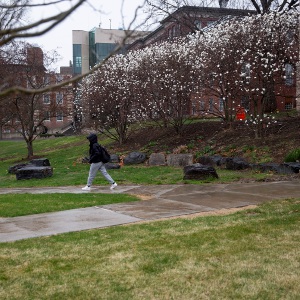Region expects to see climate migrants from elsewhere in US
| Published: 05-22-2023 1:33 AM |
As climate change fuels extreme weather and rising sea levels in the U.S. and across the globe, parts of New England could become havens of safety for those fleeing fires, heat and floods.
Making room for more people was the theme of a conference held in Keene last week, where academics, municipal officials and advocates from across the region gathered to talk about preparing for migration due to climate change.
The event focused on research from a new project funded by the National Oceanic and Atmospheric Administration (NOAA) called “A Northeast Safe and Thriving for All,” which explores equity and justice during climate migration.
Linda Shi, a professor at Cornell and lead researcher on that project, told the audience that though New England is more protected from the harmful effects of climate change than other places, people in the U.S. have tended to move to places that are less resilient, often based on the availability of housing, jobs or family networks.
“There is a major gap between the ecological approach of what is possible and the realities of where people are actually choosing,” she said.
About 1.7 million people were displaced by disasters in the U.S. in 2017, Shi said.
That same year, 68.5 million people across the globe were forcibly displaced, about a third of them due to sudden weather events, according to the Brookings Institution.
Climate demographers are working to get a better sense of the numbers of people moving, or people projected to move in the future, due to climate change. Shi says those numbers aren’t coming soon and may never predict what will really happen with migration.
Article continues after...
Yesterday's Most Read Articles
 Football helmet maker buys Lebanon’s Simbex
Football helmet maker buys Lebanon’s Simbex
 James Parker granted parole for his role in Dartmouth professors’ stabbing deaths
James Parker granted parole for his role in Dartmouth professors’ stabbing deaths
 Zantop daughter: ‘I wish James' family the best and hope that they are able to heal’
Zantop daughter: ‘I wish James' family the best and hope that they are able to heal’
 Kenyon: Dartmouth alumni join union-busting effort
Kenyon: Dartmouth alumni join union-busting effort
 Parker up for parole more than 2 decades after Dartmouth professor stabbing deaths
Parker up for parole more than 2 decades after Dartmouth professor stabbing deaths
 Through new school partnerships, CRREL seeks to educate young scientists
Through new school partnerships, CRREL seeks to educate young scientists
Shi said though climate migration may seem like a new challenge, it illuminates problems in social and physical infrastructure that have been around for a long time.
Some cities and towns in New Hampshire, like Nashua, have already started taking climate migration into account when planning.
Keene Mayor George Hansel said for that city, housing would be the biggest challenge.
“The only thing that’s limiting our population growth is the availability of housing right now. That pressure is going to be on Keene for the foreseeable future,” he said. “Our planning staff realizes that they’ve got a large burden that they have to bear because we have to lead this whole community through a period of change.”
Other participants noted the importance of infrastructure like energy, food and water and waste systems.
“When we’re talking about resiliency, it’s like, how many more people can be pooping into your sewer system?” said Alex Beck, who works with the Brattleboro Development Credit Corporation.
Eva Castillo, the director of the New Hampshire Alliance for Immigrants and Refugees, told the audience that inclusion is an integral part of making room for climate migrants.
“The process of decision making and welcoming is big on including people. When we decide for other people, when we do not include everybody in the decision making process, in the way we design things, then they don’t work for everyone,” she said.
Shi, the Cornell professor, said more information is needed on climate projections, peoples’ reasons for moving, and issues like zoning and land use as conversations about climate migration continue. She said it’s important to start planning.
“If corporations and speculators get in front of that, then they are going to buy up the land and territories and make affordable housing provision so much more challenging once people are coming around to the idea that we need to plan for growth,” she said.
But, Shi said, historical migrations show that building social and physical infrastructure for these kinds of movements takes decades, and the effort to manage climate migration will be generational.
“Since change is going to happen, it falls on us to imagine and to figure out what kind of change we actually want to have,” she said. “Whether or not that means the Northeast is going to become a really vibrant place as it once was throughout the region – I think that remains to be seen.”

 Art Notes: After losing primary venues, JAG Productions persists
Art Notes: After losing primary venues, JAG Productions persists  Over Easy: Marvels in the heavens, and in the yard
Over Easy: Marvels in the heavens, and in the yard  Amid financial difficulties, Lebanon-based Revels North cancels midwinter show
Amid financial difficulties, Lebanon-based Revels North cancels midwinter show  Art Notes: The Pilgrims to perform ‘last’ show Saturday in Hanover
Art Notes: The Pilgrims to perform ‘last’ show Saturday in Hanover
